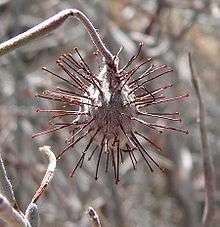Krameria bicolor
| Krameria bicolor | |
|---|---|
 | |
| barbed fruit | |
| Scientific classification | |
| Kingdom: | Plantae |
| (unranked): | Angiosperms |
| (unranked): | Eudicots |
| (unranked): | Rosids |
| Order: | Zygophyllales |
| Family: | Krameriaceae |
| Genus: | Krameria |
| Species: | K. bicolor |
| Binomial name | |
| Krameria bicolor S.Watson | |
| Synonyms | |
Krameria bicolor is a perennial shrub or subshrub of the family Krameriaceae, the Rhatanies. It is commonly known as white rhatany, crimson-beak, and chacate in Spanish (cosahui in the state of Sonora). It is found in drier environments of the southwestern United States from California to Texas, and in northern Mexico.
It is a low lying, densely branched shrub, commonly up to 2 feet (1 m), but exceptionally to beyond 5.0 feet (2 m). The branches are spiny in form but not sharp nor firm at the tips. The leaves are grey-green to greenish, finely-haired, narrow and only one half to three quarters of an inch long.
The color of the plant and branches is grayish-green to gray, or whitish-gray, to dull browns or tinged with red. The flowers are often sparse and sometimes inconspicuous, but plants in some locales can bloom prolifically in red flowers.
The shrub is adapted to dry, desert environments, but it can take advantage of high soil moisture. The plant is partially parasitic, for example on creosote bush, Larrea tridentata.
References
| Wikimedia Commons has media related to Krameria bicolor (Krameria grayi). |
- ↑ "Taxon: Krameria bicolor S. Watson". Germplasm Resources Information Network. United States Department of Agriculture. 2010-10-15. Retrieved 2011-01-28.
- Jepson Flora Project: Krameria grayi
- USDA: NRCS: Plants Profile Krameria grayi; Photo-High Res--(Close-up) - (Photo of Flowers, Spines, & Leaves)
- Images from the CalPhotos archive
- Krameria grayi at LBJ Wildflower Center